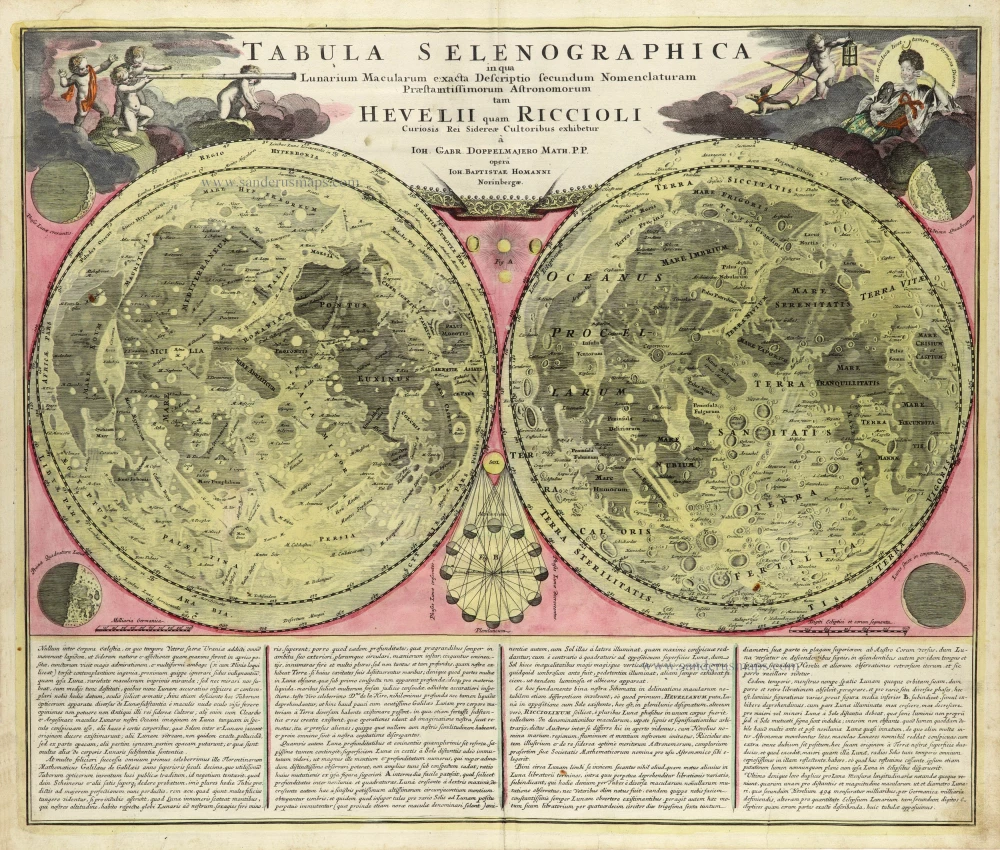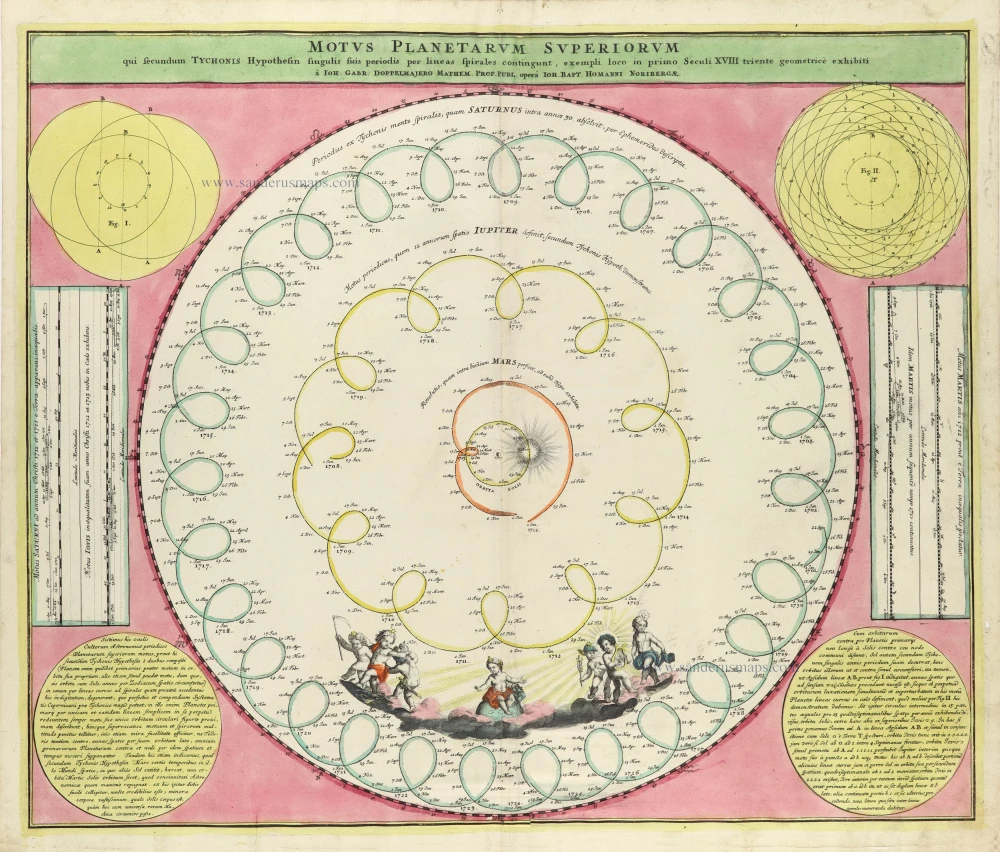The Universal Zeig und Schlaf-Uhr, designed by Zacharias Landteck, published by J.B. Homann. c. 1720
This Geographische Universal Zeig- und Schlaf-Uhr was designed by Zacharias Landteck and published by J.B. Homann. It is a remarkable example of Enlightenment-era cartographic ingenuity, blending geography, timekeeping, and cosmology in a single ornate print. This chart functioned as both a world clock and an educational aid, designed to visualise the simultaneous passage of time across different parts of the globe.
At the centre of the composition is a polar map showing large parts of Asia, Europe, and northern America, including insular California, and a large circular diagram representing a 24-hour dial, divided into hours marked in Roman numerals, which are intended to correspond with positions on the Earth. Surrounding this central dial are concentric rings containing the names of various global cities and regions, organised by their longitudinal position relative to Nuremberg — Homann’s city. By aligning a movable pointer (on original prints, a manually adjustable component) with the local time in Nuremberg, one could quickly determine the corresponding hour in dozens of other locations worldwide, providing a practical demonstration of time differences in an era before standardised international time zones.
Beyond its utilitarian function, the print is lavishly embellished with allegorical and decorative elements typical of Homann's work. Ornate cartouches, emblematic figures, and astronomical motifs adorn the borders, reinforcing the Enlightenment fascination with order, science, and the unity of terrestrial and celestial systems.
The Homann Family: Masters of German Cartography and Publishing
The Homann family stands as one of the most significant names in the history of German cartography and publishing. Their maps, atlases, and geographic works not only shaped contemporary understanding of the world during the 18th century but also left an enduring legacy in the fields of geography, engraving, and scholarly publishing.
The family's prominence began with Johann Baptist Homann (1664–1724), a native of Oberkammlach in Bavaria. Initially trained in law and theology, Johann Baptist later turned to engraving and cartography — a field that was flourishing amid the Age of Discovery and the growing demand for precise geographic knowledge.
In 1702, he founded his own publishing house in Nürnberg, a city then renowned for its vibrant intellectual, artistic, and scientific community. Nuremberg’s rich tradition of printmaking and map production provided fertile ground for Homann's enterprise.
Johann Baptist Homann quickly rose to prominence as one of Germany’s leading cartographers and publishers. His works combined technical accuracy, artistic merit, and rich ornamentation, often embellished with elaborate cartouches, mythological scenes, and heraldic symbols.
In 1715, Homann was appointed Imperial Geographer to the Holy Roman Emperor Charles VI. He obtained the "Imperial Privilege" (Privilegium Imperialis). This prestigious title solidified his status and bestowed upon his publishing house both credibility and influence. His most famous works include:
- Atlas Novus Terrarum Orbis (1707) — an early and ambitious atlas project.
- Grosser Atlas über die ganze Welt (1716) — one of the most crucial German world atlases of the early 18th century.
Homann’s maps covered both European and global territories, including the Americas, Asia, and Africa, reflecting contemporary geographical knowledge and political boundaries.
The Homann Heirs (Homannische Erben)
After Johann Baptist Homann died in 1724, his son Johann Christoph Homann (1703–1730) briefly took over the business. However, Johann Christoph died at a young age, and the enterprise was then continued under the name Homännische Erben ("Homann Heirs"), a partnership of family members and associates.
Despite the loss of its founder, the firm remained highly productive and influential for several decades. The Homann Heirs continued to publish atlases, wall maps, city views, and geographical treatises well into the late 18th century. Their catalogue included works by noted cartographers such as Johann Matthias Hase, Leonhard Euler, and Tobias Conrad Lotter.
The Homann publishing house played a crucial role in disseminating geographic and scientific knowledge during the Enlightenment. Their maps combined artistry with empirical detail and were sought after by scholars, navigators, governments, and collectors.
Several of their works are now prized as valuable historical artefacts, housed in museums, libraries, and private collections around the world. The Homann Heirs' firm gradually declined by the end of the 18th century, overtaken by newer publishing houses and changing technologies, but their contribution to the cartographic tradition remains significant.
The Homann family’s name is indelibly linked to the golden age of German cartography. Through meticulous craftsmanship and a keen sense of visual storytelling, they charted the known world of their time, leaving a remarkable record of early modern geography. Today, their maps not only inform historians of cartography but also captivate collectors and enthusiasts for their aesthetic beauty and historical value.
Iohann Baptistae Homanns Neu inventirte Geographische Universal Zeig und Schlaf-Uhr.
Item Number: 32037 Authenticity Guarantee
Category: Antique maps > Curiosities
Chart showing the motion of the planets according to the Copernican model, by J.G. Doppelmayr, published by J.B. Homann.
Title: Iohann Baptistae Homanns Neu inventirte Geographische Universal Zeig und Schlaf-Uhr.
An welcher, vermittelst des in 24 Stunden um die frey schwebende Erdkugel herumgehenden Sonnen-Zeigers samt der völligen Himmels Scheiben, nicht allein alle gehörige Stunden um den ganzen Erdboden durch Europam und Asiam, auch halb Africam und Americam über allen anbemerkten Orten auf einmal zusehen, sondern auch der Natürliche Tag und Nacht mit beweglichen Liecht und Schatten, ... Viel angeneme Vorstellungen mehr wird die lebendige Bewegung der Uhr selst zeigen, welche auf Angeben und Unkosten des Auctoris mit unermüdeten Fleiß aufs beste verfertiget der Ruhmwürdige Meister Zacharias Landteck Uhrmacher in Nürnberg.
Date of the first edition: c. 1720.
Date of this map: c. 1720.
Copper engraving, printed on paper.
Image size: 490 x 565mm (19¼ x 22¼ inches).
Sheet size: 515 x 600mm (20¼ x 23½ inches).
Verso: Blank.
Condition: Original coloured, small tear in right margin reinforced, excellent.
Condition Rating: A+.
From: Atlas Novus Terrarum Orbis Imperia, regna et status exactis tabulis geographice demonstrans. Nuremberg, J.B. Homann, [c. 1720].
This Geographische Universal Zeig- und Schlaf-Uhr was designed by Zacharias Landteck and published by J.B. Homann. It is a remarkable example of Enlightenment-era cartographic ingenuity, blending geography, timekeeping, and cosmology in a single ornate print. This chart functioned as both a world clock and an educational aid, designed to visualise the simultaneous passage of time across different parts of the globe.
At the centre of the composition is a polar map showing large parts of Asia, Europe, and northern America, including insular California, and a large circular diagram representing a 24-hour dial, divided into hours marked in Roman numerals, which are intended to correspond with positions on the Earth. Surrounding this central dial are concentric rings containing the names of various global cities and regions, organised by their longitudinal position relative to Nuremberg — Homann’s city. By aligning a movable pointer (on original prints, a manually adjustable component) with the local time in Nuremberg, one could quickly determine the corresponding hour in dozens of other locations worldwide, providing a practical demonstration of time differences in an era before standardised international time zones.
Beyond its utilitarian function, the print is lavishly embellished with allegorical and decorative elements typical of Homann's work. Ornate cartouches, emblematic figures, and astronomical motifs adorn the borders, reinforcing the Enlightenment fascination with order, science, and the unity of terrestrial and celestial systems.
The Homann Family: Masters of German Cartography and Publishing
The Homann family stands as one of the most significant names in the history of German cartography and publishing. Their maps, atlases, and geographic works not only shaped contemporary understanding of the world during the 18th century but also left an enduring legacy in the fields of geography, engraving, and scholarly publishing.
The family's prominence began with Johann Baptist Homann (1664–1724), a native of Oberkammlach in Bavaria. Initially trained in law and theology, Johann Baptist later turned to engraving and cartography — a field that was flourishing amid the Age of Discovery and the growing demand for precise geographic knowledge.
In 1702, he founded his own publishing house in Nürnberg, a city then renowned for its vibrant intellectual, artistic, and scientific community. Nuremberg’s rich tradition of printmaking and map production provided fertile ground for Homann's enterprise.
Johann Baptist Homann quickly rose to prominence as one of Germany’s leading cartographers and publishers. His works combined technical accuracy, artistic merit, and rich ornamentation, often embellished with elaborate cartouches, mythological scenes, and heraldic symbols.
In 1715, Homann was appointed Imperial Geographer to the Holy Roman Emperor Charles VI. He obtained the "Imperial Privilege" (Privilegium Imperialis). This prestigious title solidified his status and bestowed upon his publishing house both credibility and influence. His most famous works include:
- Atlas Novus Terrarum Orbis (1707) — an early and ambitious atlas project.
- Grosser Atlas über die ganze Welt (1716) — one of the most crucial German world atlases of the early 18th century.
Homann’s maps covered both European and global territories, including the Americas, Asia, and Africa, reflecting contemporary geographical knowledge and political boundaries.
The Homann Heirs (Homannische Erben)
After Johann Baptist Homann died in 1724, his son Johann Christoph Homann (1703–1730) briefly took over the business. However, Johann Christoph died at a young age, and the enterprise was then continued under the name Homännische Erben ("Homann Heirs"), a partnership of family members and associates.
Despite the loss of its founder, the firm remained highly productive and influential for several decades. The Homann Heirs continued to publish atlases, wall maps, city views, and geographical treatises well into the late 18th century. Their catalogue included works by noted cartographers such as Johann Matthias Hase, Leonhard Euler, and Tobias Conrad Lotter.
The Homann publishing house played a crucial role in disseminating geographic and scientific knowledge during the Enlightenment. Their maps combined artistry with empirical detail and were sought after by scholars, navigators, governments, and collectors.
Several of their works are now prized as valuable historical artefacts, housed in museums, libraries, and private collections around the world. The Homann Heirs' firm gradually declined by the end of the 18th century, overtaken by newer publishing houses and changing technologies, but their contribution to the cartographic tradition remains significant.
The Homann family’s name is indelibly linked to the golden age of German cartography. Through meticulous craftsmanship and a keen sense of visual storytelling, they charted the known world of their time, leaving a remarkable record of early modern geography. Today, their maps not only inform historians of cartography but also captivate collectors and enthusiasts for their aesthetic beauty and historical value.







